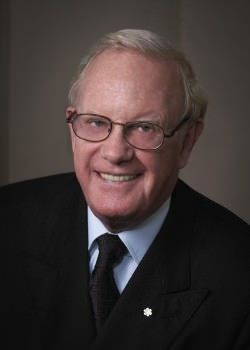Ted Rogers: A Life Unconquerable
Every time I was with him and other people, he would always ask them whether they use Rogers service.”
Rogers never let his success — or his failures — get to him. Often, Rogers was criticized for his managing of debt and his heavy risk taking, admitting himself at times that he should be more careful. Caroline Van Hasselt, in her book, Ted Rogers and the Empire That Debt Built, condemned Rogers’ business practices, noting: “Debt has never been the hallmark of a great leader.”
Rogers affirmed, however, that “If you haven’t got problems, you haven’t lived right; you haven’t tried enough.”
“I’d say I was bloody lucky,” he wrote.
Despite his luck, Rogers was continually affected by his health throughout his business ventures, social events and amassment of debt. But he never allowed himself to be set back by it.
As a small boy, plagued by bad vision and weight problems, Rogers watched his father, Edward Rogers, manage the first television licence in Canada. After his father’s death in 1939, Rogers set out at age five to follow in the family business.
Rogers envisioned himself as a continuation of his father’s legacy, admitting at 70 that he could not allow himself to retire. As he put it, “it would dishonour my father.” Rogers Sr. worked until his death, so it seemed only natural to his son that he should do the same.
By the time Rogers reached the age at which his father died, in 1972, he had launched and acquired several radio stations, including what is now 680News, founded Rogers Cable TV, introduced Rogers Community Television, and taken over other cable companies. A young lawyer at the time, Rogers described his early career as an attempt to “do the impossible.”
This period of Rogers’ life was the healthiest. Only a decade later, he used the same motto to fight the many diseases of old age. In 1985, Rogers suffered a silent heart attack. It marked the launch of the Rogers wireless phone business, as well as the beginning of Rogers’ fight for life.
Working in depth with his family doctor, Bernard Gosevitz, for over 30 years, Rogers spent his money and strived to survive. Gosevitz asserts that Rogers’ openness to new medicine gave him a few extra years of life. And Rogers certainly did not waste the time that he gained.
Reporters describe Rogers committing to his business even between medical appointments, partly so that stockholders would not be suspicious of his health. By the time of Rogers’ death, after a quadruple bypass, experimental stem cell treatment, two decades of medical procedures and a rejected application for heart transplant, he had established himself as a visionary leader of the late 20th century — and had used his body to the very end.































Share the post "Ted Rogers: A Life Unconquerable"